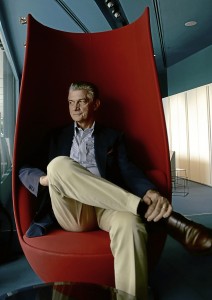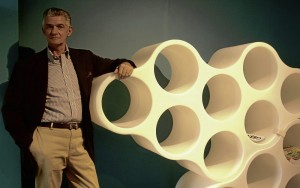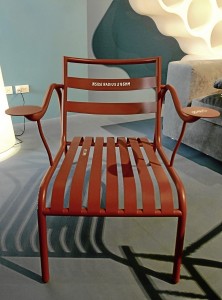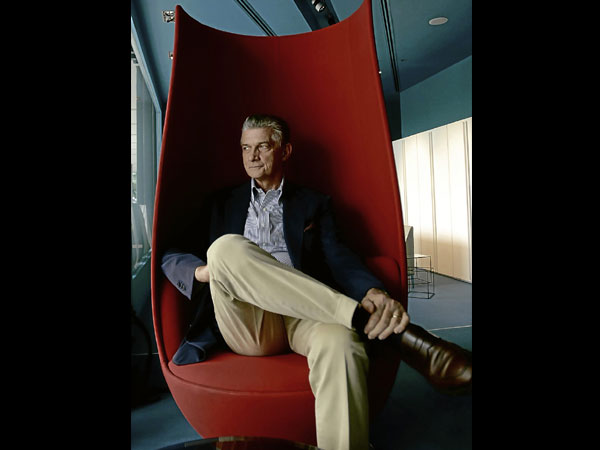 When Brad Pitt created a capsule furniture collection for American furniture maker Frank Pollaro, the New York Times tapped four international experts to review the actor’s designs, among them Giulio Cappellini.
When Brad Pitt created a capsule furniture collection for American furniture maker Frank Pollaro, the New York Times tapped four international experts to review the actor’s designs, among them Giulio Cappellini.
The NYT dubbed him as the “kingpin of cool” and described his Milan-based furniture company, Cappellini, as “famously dashing.”
Cappellini, 58, is known for spotting design talents who have become icons such as Jasper Morrison, Marcel Wanders and Tom Dixon. The company gained international clout with its collaborations with other foreign designers such as Marc Newson, Nendo, Shiro Kuramata and French designers Ronan and Erwan Bouroullec, Patrick Norguet and Christophe Pillet.
Asked if Pitt was an emerging design talent, Cappellini replied that he gave “politically correct answers” to the New York Times. “He has a passion for design,” Cappellini told the Inquirer.
Pitt is a customer of Cappellini, who acquired pieces by Morrison, Newson and Kuramata for his homes around the world. Likewise, Rihanna, Tina Turner and Prince are Cappellini fans as with designers Domenico Dolce and Stefano Gabbana, Karl Lagerfeld, the late Gianfranco Ferre and Mariuccia Mandelli, owner of the Krizia fashion house.
Cappellini is the artistic director of his company, which is now under the Poltrona Frau Group. He is responsible for the art direction and opening of the showrooms of all the brands  under Poltrona Frau.
under Poltrona Frau.
The Italian design expert visited Manila recently for the opening of the Cappellini mono-brand showroom at Bonifacio High Street. Suyen Corporation, headed by chair Ben Chan, acquired the exclusive distribution.
No stranger to the Philippines, he and designer Paola Navone would fly to Cebu in the ’90s to design for manufacturers who exported rattan and wicker furniture. He lauded the Philippine manufacturers for their professionalism in meeting deadlines and superior craftsmanship.
Landmark designs
 Cappellini studied architecture at the Polytecnico di Milano and business at Bocconi Milano. In the early ’80s, he wanted to dust off the image of his father’s furniture business. He collaborated with his friend, architect Rodolfo Dordoni, to give company a facelift.
Cappellini studied architecture at the Polytecnico di Milano and business at Bocconi Milano. In the early ’80s, he wanted to dust off the image of his father’s furniture business. He collaborated with his friend, architect Rodolfo Dordoni, to give company a facelift.
They created streamlined designs that emphasized the purity of form, used modern materials and designed a forward-looking catalogue.
“Dordoni’s style is timeless. My taste is eclectic but my designs are simple and pure. My favorite materials are wood and lacquer finishes and aluminum, which is powerful,” he said.
Dordoni’s Cuba sofa, created in 1986, became a modern classic that has been adapted by other designers.
“It’s still the bestseller. At that time, most sofas had high backs. In the beginning people asked, ‘How can we sit in a sofa with a low back?’ This was low with wide arms, so that people could sit comfortably and place their glass on the arms. You can even put it in the center of the room,” said Cappellini.
Cappellini said he considered himself more of a “Sunday designer” and would rather keep his eyes peeled for new discoveries.
When it produced an early experimental design by Shiro Kuramata in 1986, the soft, irregular-shaped and “anti-functionalist” Side 2 Chest of Drawers marked the beginning of Cappellini as a company known for its bravado and playfulness.
Iconic
Another turning point in the company history was Cappellini’s discovery of English designer Jasper Morrison in an exhibit at the Royal College of Art. The Italian was impressed with the Thinking Man’s Chair, which had a varnished metal framework made of tubes and flat bars. The arms were fitted with trays to hold drinking glasses.
Thinking Man’s Chair, which had a varnished metal framework made of tubes and flat bars. The arms were fitted with trays to hold drinking glasses.
Cappellini went to Morrison’s home/workshop and invited him to the factory in Italy. Over a lunch of pasta, the deal was clinched. The Thinking Man’s Chair has been in the Cappellini catalogue for 25 years.
“Jasper spoke one word per hour,” recalled Cappellini. “Still, we liked to discuss the global concept of the company. Jasper creates simple products that are seamless, perfect and timeless. When his products first came out, they weren’t moving. Now we are selling more and more of his designs every year.”
Cappellini met another Englishman, Tom Dixon, who was recommended by Franca Sozzani, editor in chief of Vogue Italia. He recalled meeting Dixon in a design lab where the visitor sipped coffee from the same cup where everybody drank. Dixon was playing guitar for a rock band.
“At first he was doing strong pieces like chairs which you couldn’t sit on,” said Cappellini
When Dixon visited Italy, he collaborated with artisans and produced the famous S-chair, made of curvy metal framework, covered with straw and wicker. It is now in the permanent collection of the Museum of Modern Art.
On Dutch designer Marcel Wanders, Cappellini saw his Knotted Chair in a magazine and sought him out in the Netherlands. At that time, Wanders didn’t have a workshop and borrowed a friend’s space for his presentation. Today, Wanders has a building with over 50 people working for him.
His recent work, the Tulip Chair, on oversized swivel chair shaped like a bulb, gives the sitter the cozy feeling of being enveloped. Costing some 10,000 euros, the Tulip Chair has been a top seller, especially in the corporate market.
“It’s important to have a strong relationship with the designers so you can work well from the idea to the final product,” maintained Cappellini.
Freedom of choice
On his observation of design trends, Cappellini said it is more challenging because consumers want the flexibility to mix various styles, designers, companies, periods and cultures.
 “In our catalogue there are some strong pieces and some basic products. You don’t need to do an all-Cappellini home. You can buy a few designs and mix with them with some traditional pieces,” he said.
“In our catalogue there are some strong pieces and some basic products. You don’t need to do an all-Cappellini home. You can buy a few designs and mix with them with some traditional pieces,” he said.
He pointed out people are rediscovering natural materials such as wood and stone with new surface treatments. Another aspect of freedom of choice is combining new technology and technical products with natural materials. “People can combine a solid wood table with an aluminum or plastic chair,” he said.
“It’s difficult to invent new shapes. The most beautiful have been done in mid-20th century.”
With the rise of condominiums, designers must produce furniture that is proportioned to compact space. “We have to work on a more human scale, doing products with nice details, that can easily pass through the door,” said Cappellini.
Neutral colors will still dominate environments with spots of bold color for accent.
“The trend is the personalization of interiors,” he said. In the past, home owners depended on architects and decorators to dress up their spaces. Today consumers want spaces that reflect their personality.”
Despite the economic downturn in the West, the company has been posting 15-percent growth, thanks to the growing market of hotels, offices and showrooms. The fastest-selling products are also the most expensive.
Cappellini maintains his vision of producing out-of-the-box designs. “You can’t be called contemporary if there’s no innovation,” he said. “Our goal is to make products with charm. You may not need another chair, but ultimately, you’ll want that chair in your home.”
Cappellini Manila is at G/F, One Parkade, 28th St., Bonifacio High St., Taguig City.









































